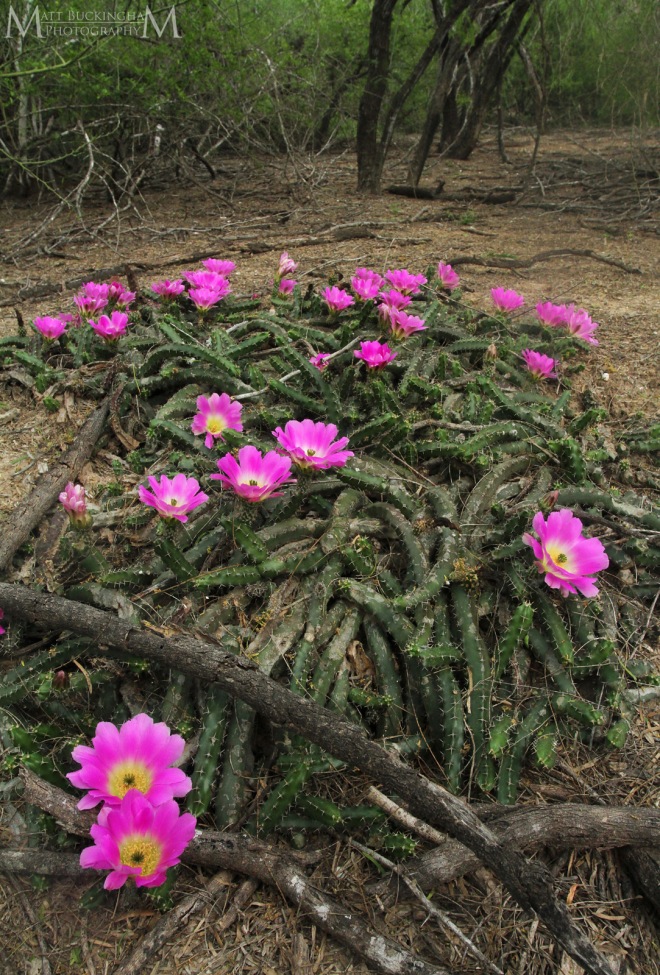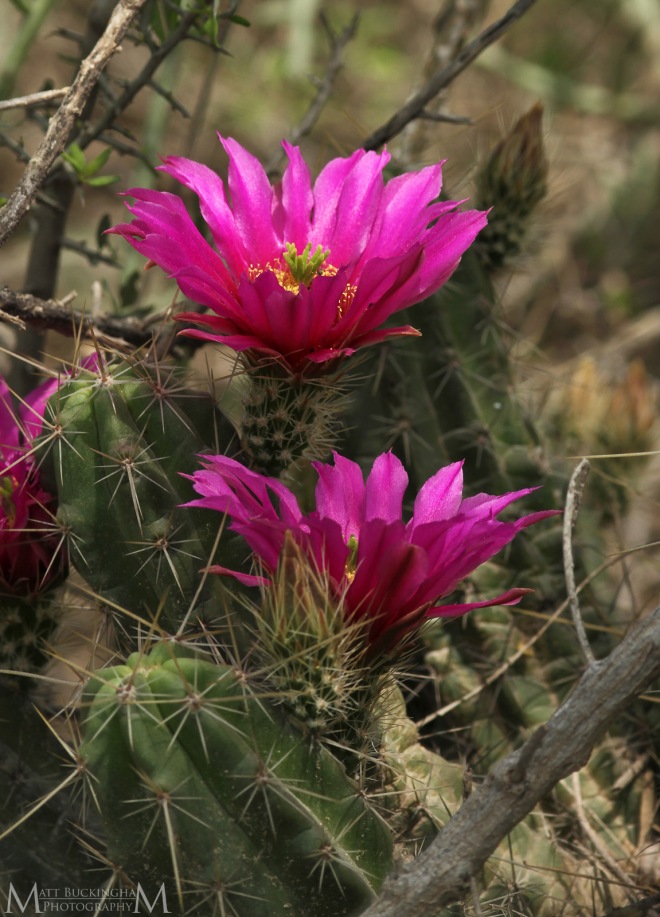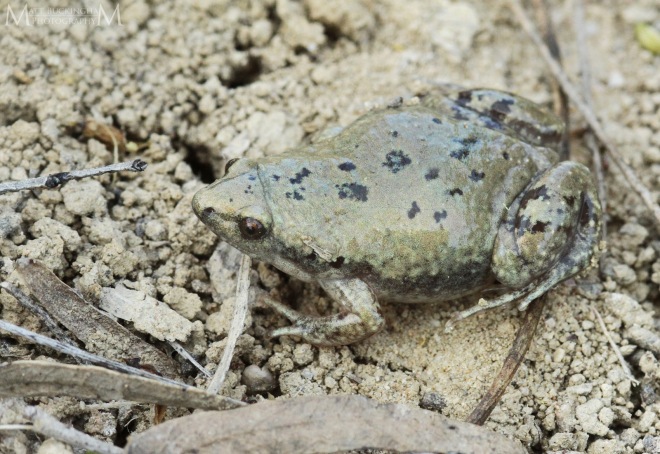
Lady Finger Alicoche
Though the Trans Pecos is the center of cacti diversity for Texas, the cactus community of the Tamaulipan thornscrub is no less spectacular. It includes a number of Mexican species that just barely enter the states in extreme South Texas. Two species in particular, have been on my bucket list for years now: the Lady Finger Alicoche (Echinocereus pentalophus) and the Pencil Cactus (Echinocereus poselgeri). I would have included them on my 2017 biodiversity list, however I didn’t anticipate taking a trip to South Texas this year. So when a march trip to Big Bend fell through, I delighted in the opportunity to finally observe these species in their natural setting.
This is the part of the story where the patience of Carolina, my parents, and my brother really come into play. They waited patiently while I sought out and photographed these species, and even helped me in my endeavor. Carolina has a real interest in cacti as well, and she enjoyed seeing so many species in bloom.

Lady-Finger Alicoche
The Alicoche is a cactus of the Tamaulipan thornscrub of northeastern Mexico and South Texas. It can form large mats under the shade of nurse plants, however its stems are relatively nondescript, and the plant itself is difficult to see when not in bloom. When it blooms, however, its gives its presence away in spectacular fashion. The huge pink blooms seem to explore from the thornscrub. It is easily one of the most spectacular plants I have ever had the good fortune to observe.

County-level distribution of Echinocereus pentalophus from http://www.bonap.org. Yellow counties indicate that the species is present and rare.
I found the Lady Finger to be an extremely photogenic plant, lending itself both to portraits of the blooms and landscape shots featuring the plant as a foreground element. We were fortunate to observe many individuals in many different settings throughout the trip. Spending time with this species was a truly memorable experience that I look forward to repeating some day in the future.

Lady Finger Alicoche

Remnant Tamaulipan thornscrub forest with Lady Finger Alicoche in bloom.
Fortunately the Alicoche was fairly easy to find. That was not the case with the Pencil Cactus. If the Lady Finger is hard to see when not flowering, the Pencil Cactus is virtually impossible. Also known as the Sacasil or Dahlia Hedgehog Cactus, the Pencil Cactus has an extremely narrow stem that does not look much different than a stick. Couple that with their tendency to grow among dense tangles beneath thornscrub shrubs, and you could imagine how hard it would be to pick them out. When they bloom, however, the light up the thornscrub.
I spent a large part of the trip looking for this species in vain. I went to sites where others had seen them, and scoured seemingly suitable habitat. I did not see one until late afternoon on our last day in the valley. After trudging through the dense thornscrub, cut, tired, and full of spines from allthorn, mesquite, and prickly pears I was ready to give up. Then, as we were preparing to leave, driving through an undeveloped area adjacent to a small subdivision Carolina shouted “STOP! The Pencil Cactus!”. I looked up and saw it. It’s flower had been nipped off. Disappointed, I looked around hoping that there might be another in the area, and then I saw it up a steep slope. I grabbed my camera and scrambled up the slope. As my shutter clicked I felt a real sense of contentment, both in having found the Pencil Cactus, and that I have such a wonderful family that indulges my passion and obsession for the natural world.

Pencil Cactus
The range of the Pencil Cactus is virtually the same as that of the Lady Finger. It seems to be found in slightly denser clumps of brush where its slender, fragile stem can lean on the limbs of nurse plants for support.

County-level distribution for Echinocereus poselgeri from http://www.bonap.org. Yellow counties indicate that the species is present and rare.
We were lucky enough to observe two other species of Echinocereus in bloom in our pursuit of the Lady and the Pencil. The Strawberry Pitaya (Echinocereus enneacanthus) was abundant throughout much of the thornscrub. We were a bit early in the season to see many flowers, but I was lucky enough to spot a few in bloom. E. enneacanthus is a fairly widespread species throughout much of Mexico and southern and western Texas and New Mexico. The variety in South Texas is Echinocereus enneacanthus var. brevispinus, identifiable by its short spines.

Strawberry Pitaya

Strawberry Pitaya
Much less common was the Fitch’s Hedgehog Cactus (Echinocereus fitchii). E. fitchii was initially, and still is considered by some to be a variety of Echinocereus reichenbachii, the Lace Cactus. There are significant differences between the two, however, including root structure and spine and flower characteristics. Most cactus flowers are at their best midday on sunny days. This makes photographing them a challenge, as shading them often takes away some of the brilliance of their blooms.

Fitch’s Hedgehog Cactus

Fitch’s Hedgehog Cactus
Most of the cacti we observed during our trip were on Nature Conservancy property. I can’t say enough good things about the Nature Conservancy in Texas. I will discuss the Nature Conservancy and their contributions to conservation in my next blog post, but wanted to mention them here, as one afternoon Seth and I took a hike at one of their South Texas preserves. We saw more cacti on this hike than the rest of the trip combined. Echinocereus pentalophus and E. enneacanthus were abundant, as were Texas Prickly Pear (Opuntia lindheimeri) and Dog Cholla (Grusonia schotii). We also observed Christmas Cholla (Cylindropuntia leptocaulis) and Lower Rio Grande Valley Barrel Cactus (Ferocactus hamatacanthus var. sinuatus), though none were in bloom. We were, however, fortunate enough to see three other species in bloom: Heyder’s Pincushion Cactus (Mammillaria heyderi), Hair-Covered Cactus (Mammillaria prolifera), and Twisted-Rib Cactus (Hamatocactus bicolor).

Heyder’s Pincushion Cactus

Heyder’s Pincushion Cactus

Hair-Covered Cactus

Twisted-Rub Cactus
We also observed several other interesting plants in the thornscrub. Some of these have been covered in previous blog posts. Others I didn’t photograph for various reasons. One of the most interesting was the terrestrial bromeliad Gaupilla (Hechtia glomerata). We also observed a number of birds typical of the desert southwest, including Pyrrhuloxia (Cardinalis sinuatis), Black-throated Sparrows (Amphispiza bilineata) and Cactus Wrens (Campylorhynchus brunneicapillus). At one point I flipped over a dried cow patty and found a little Western Narrowmouth Toad (Gastrophryne olivacea) sheltering in some remnant moisture beneath it.

Western Narrowmouth Toad
Stay tuned for more cactus-seeking adventures in my next blog entry.
